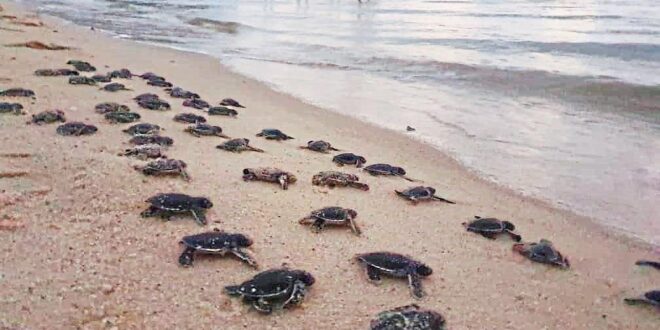BALIK PULAU: To a turtle, a plastic bag floating at sea looks exactly like jellyfish.
Slow-moving and rich in collagen, jellyfish make for a wonderful meal for turtles, which are immune to jellyfish stings.
However, the problem begins when a turtle mistakes floating plastic bags for jellyfish, as swallowing plastic will give turtles life-threatening gastrointestinal issues.
Penang Fisheries Department director Zarina Zainuddin said the main cause of the decline in turtle populations was plastic pollution when the particles get eaten by marine life.
“Many turtles eat plastic bags, leading to their deaths.
“Another key cause of turtle deaths is ‘ghost nets’, which are nets accidentally left behind by fishermen that cause turtles to be entangled.
“They can’t escape and drown,” she said.
The department has declared the Teluk Bahang beach near here as a turtle nesting site, and set up the Marine Conservation Centre at Angsana Resort to conserve the species.
New notice board about Turtle Friendly Beach installed on the beach near Angsana Hotel Teluk Bahang, Balik Pulau, Penang.(May 13,2024) —ZHAFARAN NASIB/The Star
Signage has been placed along the “Turtle Friendly Beach”, to notify the public that it is a turtle landing area, and giving them the dos and don’ts.
Zarina said the management and preservation of turtles and biodiversity along the Teluk Bahang beach is a collaboration between the department and Aquaria KLCC.
“We have carried out extensive conservation and public education work over the past decade, and this has helped the turtle population to become stable.
“On some years, we recorded fewer turtles, while sightings increased in other years, but it is consistent overall.
“From the data over the past decade, we can see that the population has not reduced, due to conservation works,” said Zarina, who added there is a turtle conservation and information centre in the Penang National Park that keeps tabs on turtles.
“Last year, we had 24 turtle landings at the park.
“The turtles lay eggs and we hatch the eggs.
“There are specific steps that need to be taken to ensure hatchlings’ safety when released into the water.
“We must release them between 7pm and 7am to reduce the risk of eagles preying on them,” she said.
Zarina said hatchlings are released about a week or so after they emerge, because otherwise, they will just stay afloat, making them susceptible to threats.
“We will wait until they can dive before releasing them to give them a higher chance of survival.
“We retrieved 6,830 eggs last year and hatched 5,168, a hatching rate of 74.5%.”
 BeritaKini.biz Berita Viral Terkini di Malaysia
BeritaKini.biz Berita Viral Terkini di Malaysia





